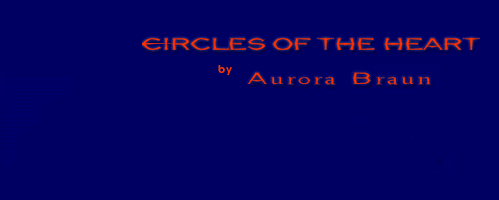| Here is what Aurora says about her art:
Since childhood, painting and drawing have been my prefered form of Self-expression. Not until I began creating mandalas did I realize that all what I had previously done had been but a preparation towards the discovery of a still point in the midst of tumultuous movement.
Through drawing, for years I explored graphic form by delving into a natural, organic unfolding of a world that seemed to be "already there in the paper". There seemed to exist a natural design that self-generated itself, and my job was to facilitate its emergence.
At first, I entertained myself creating delicately precise black and white hieroglyph-like designs. Yet a sense of centeredness was lacking, and amorphous worlds would emerge often covering the whole surface on which I was working. My vision was unilateraly turned inward, and what surfaced had a molecular, microcosmic quality to it.
Like this:
Click on any of these for a larger image.
About four years ago, while taking a class in Art Therapy, I decided to paint a mandala for each class session. The results were so exhilarating, I never stopped.
Painting mandalas is simply drawing a circle or a series of circles, squaring the circle, keeping the focus in the center, and allowing harmony both in symmetry as well as in the lack of it. Maybe the main thing is that I am coming from that center, and not so much as pointing at it.
A mandala doesn’t have to look any particular way, unless we are dealing with Hindu Tantric or Tibetan Buddhist traditions. Mandalas are found in the rituals of many other cultures, such as the Native American Medicine Wheel.
Mandalas are a universal symbol, and therefore there is no issue of our having to adhere to a given belief system. All we are doing is tapping into what is common to all human beings.
The therapeutic effect of mandalas comes from the fact that they are an expression of our deepest core. Any such expression is healing in the sense that it is a powerfull affirmation of Being.
The concentric circumference acts as an unconditional container of all things; its function is to transform the "every-thing" into the "no-thing". Bits and pices of mind stuff, life situations, unfulfilled desires, painful memories, anticipation for fututre outcomes, all come to rest in the quietude of the all-embracing Om, which is the center of the mandala.
My vision is now turned not only inward but also outward. There is no longer a preference for one over the other. The mandala is key to this new sense of inclusiveness.
Mandalas are an inexhaustible source of inspiration. The possibilities are endless. Each one has a life of its own and springs into shape as naturally as a seed that has sprouted.
To create the mandalas I have no technique per se. I use anything that is handy. Mostly, (for lack of space) I paint on paper with acrylics, inks, watercolors and oil pastel at times. I am particularly fond of metallic and pearlescent colors. I love to watch the sunlight interacting with the brightness of the colors. Like a certain species of hummingbird native of California that shoots out a bright magenta beam from its chest when the sun hits it in the right spot, these mandalas have a joyful, light-filled presence.
I often find myself challenged by whay emerges at the initial stages. But I stay with it, keep layering and layering, altering the shades, and hues of color. Weaving form with color, a rich texture resembling embroidery work is often produced. Then there is a moment in which something "clicks", which signals the time to leave it alone. Like an arrow that has been shot, it is no longer in my possession.
Some of the mandalas have a yogic flavor, and may look like chakras. Others have a shamanic character, with animal or goddess motives. But who gazes at the mandalas may find in them an entirely unique meaning of their own. This is the gift of the mandala to others- and why I am moved to share them with you–from heart to heart.
May you enjoy!
|






